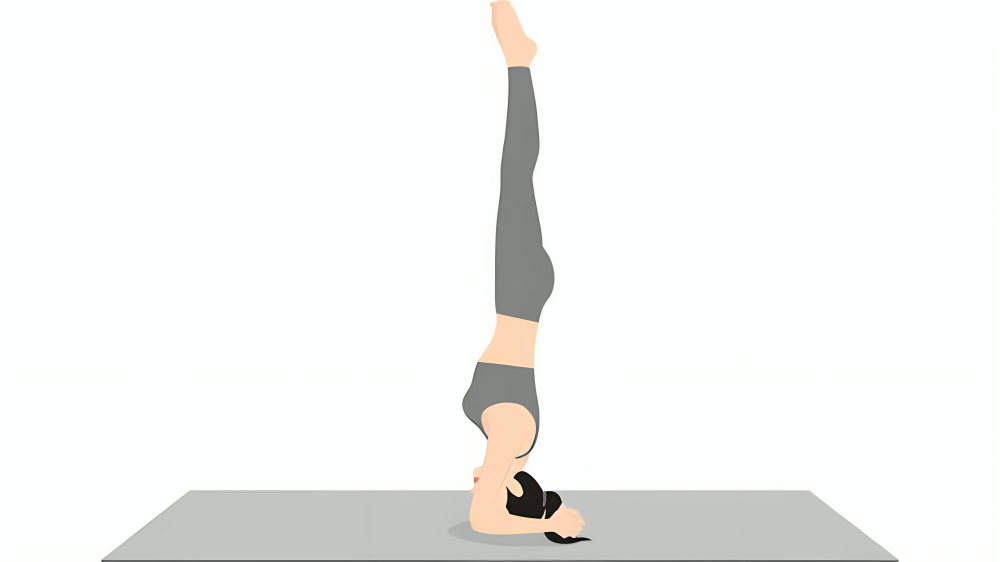
What is Sirsasana (Headstand)
Headstand or Sirsasana is one of the most powerful yoga poses. It can also be called the “King of Asanas” because it shares many benefits both for the body and the mind. This asana includes balancing your body upside down on your head, with help from your hands and arms.
How to Do Sirsasana
Start in a Kneeling Position (Child’s Pose)
Sit on your knees and gently lower your head to the floor.
Keep your arms at your sides. This relaxes your body and gets you into the right mindset.
Create a Firm Foundation (Hand Positioning)
Interlace your fingers and place your forearms on the mat.
Your elbows must be shoulder-width apart.
Place your head on the ground at the top of your head, using your hands to support your head.
Lift your Hips ( Dolphin Pose) .
Lift your hips by curling under your toes and pointing your legs straight.
You will assume the shape of an upside-down “V”, similar to a dolphin pose. Keep your neck in a relaxed state and pay attention to how to spread your weight evenly around your head and your arms.
This might take a little practice, so don’t rush through it! You should be even by the time you’re ready to move to the next position.
Lift Your Legs Slowly
Now it’s on to the fun stuff! Slowly lift the first leg off the floor and then the other. Suck in your core and don’t jump!
Beginners can practice in front of a wall for extra support to gain confidence.
Balance in the Headstand
When both legs are off the floor, extend them upwards. Try to keep your body straight, using all of your core strength as well as your shoulders to keep balance.
Breathe deeply and hold the pose for 10-15 seconds, or as long as you feel comfortable.
Come Down Gently
Come out of this pose when you are ready. Sit back slowly with one leg at a time then bend back on the ground.
Sit in Child’s Pose for some breaths to let your body relax.
Benefits of Sirsasana
Improves Blood Circulation
This tends to reverse the blood flow, which will stimulate your heart and brain. It can even improve oxygen flow and make you more energized throughout the day.
Strengthens Core and Shoulders
This is the reason Sirsasana only strengthens your core muscles for you because you would have to keep it upright. It also tones up your shoulders, arms, as well as your back, aiding in building in general upper body strength.
Improves Concentration and Focus
Sirsasana’s balancing postures require focus and help improve mental clarity. It sharpens your attention and makes you feel much more in the present.
Relieves Stress and Anxiety
This pose stimulates your parasympathetic nervous system, which leaves you relaxed and stress-free. Most people come out of Sirsasana as very calm and balanced.
Promotes Better Digestion
The inversion also stimulates the digestive organs. This may stimulate the digestive system, improving your metabolism to clean out some toxins. If you feel bloated or slow, this pose will relieve you of those feelings.
Builds Confidence.
Mastering Sirsasana is no easy feat! Mastering this extremely challenging pose may build that confidence in you to face whatever life throws your way, on as well as off the mat.Off the mat you look at life with newfound confidence-try new things, test boundaries, be braver because you know you can do anything you set your mind to.
Heath in Skin
It will increase circulation of blood through Sirsasana and give oxygen to the skin for healthier appearance. Even some people say it may slow down wrinkle formation!
It’s Here Adho Mukha Vrksasana (Handstand) How To Do It And What Are The Benefits
FAQs
1. Can Beginners perform Sirsasana?
Yes! It is better to practice under the guidance of a yoga teacher or against a wall until one gets habitual of the pose.
2. How long should I hold the Headstand?
For a beginner, one can hold for 10-15 seconds and gradually longer as one becomes stronger.
3. Is Sirsasana safe for everyone?
It is generally safe. However, if you have any neck, shoulder, or back problems, then you should avoid this asana. Pregnant and people with high blood pressure also should be avoided.

